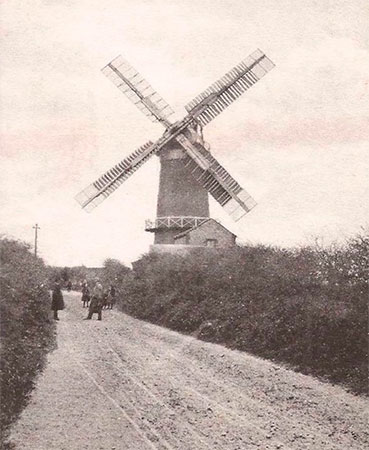
Weybourne towermill |
 |
Mill working c.1905 |
Weybourne towermill was built in 1850 on the north side of the Sheringham Road. Weybourne was originally spelt Wabourne. The five storey red brick tower stood at about 42 ft. to its curb. The Norfolk boat shaped cap had a wooden gallery with a petticoat and an eight bladed fan. A stage was set around the second floor accessed by a south facing door. On the second floor were three pairs of overdriven stones powered by four double shuttered sails, each with 7 bays of 3 shutters, although at one time the two outer bays of each sail had no shutters. There were two doors at ground level, the southern door having a porch and there was a further inner door leading to the granary (later a residence) that abutted the tower. |
Situations Vacant To Journeymen Millers Wanted immediately, a steady active Man. Apply to Mr. D. Brett, Waybourne, Holt. Norfolk News - 7th February 1857 |
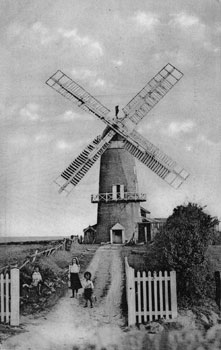 |
Mill working in 1910 |
To Journeymen Millers WANTED, a middle aged MAN, who fully understands the Business, to work a Tower Windmill; none need apply without a reference from his last Employer. Apply to John Dawson, Weybourne, near Holt, Norfolk. A personal application will be preferred. Norfolk News - 24th December 1859 |
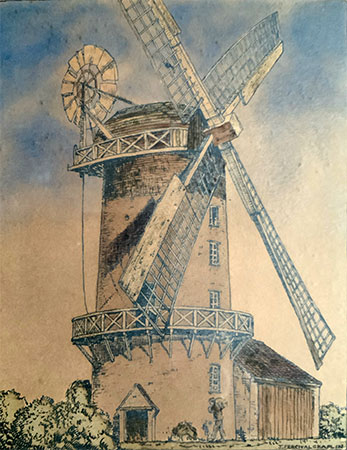 |
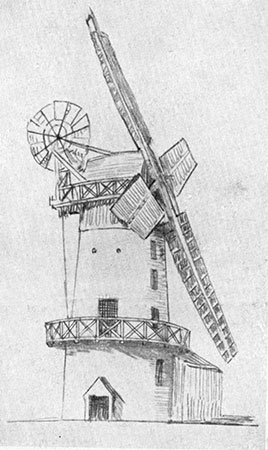 |
Watercolour by John Percival Chaplin |
Drawing by John Percival Chaplin |
The above illustrations by John Percival Chaplin (1906-1981) show the mill with different types of sails. The watercolour depicts common sails and the drawing shows patent sails, which is almost certainly the type the mill was built with. It's thus possible that the painting was produced from an illustration of another mill's sails. |
Miscellaneous To Journeymen Millers WANTED, a steady industrious Married Man, to take the Management of a Tower Mill, one who understands the Business in all its branches. None need apply who cannot have a character from his last employer. A personal application will be preferred. Apply to John Dawson, Weybourne Mills, Holt, Norfolk. Norfolk News - 6th December 1862 |
Situations Vacant To Millers WANTED, an honest and industrious man to work a Tower Wind Mill and to make himself generally useful. He must write a good hand and have a good character from his last employer. A personal application would be preferred. Apply to J. Dawson, Weybourne, Holt, Norfolk. Norfolk News - 23rd September 1865 |
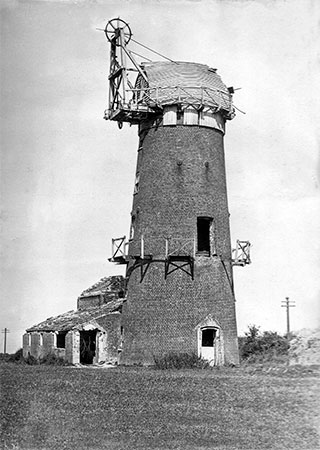 |
c.1920 |
TO LET AT WEYBOURNE NEAR HOLT |
A FIRST-CLASS TOWER WINDMILL driving three pairs of Stones, with Miller's House attached; also Five Acres of good LAND with it, with a prospect of hiring forty or fifty acres more to parties that can give good reference as to character and capital. Immediate possession may be had of the Mill; the Land at Michaelmas next. For particulars apply to Mr. S. Bird, Bodham near Holt, Norfolk. Norfolk News & Norwich Mercury - 28th May & 4th June 1870 |
Houses etc. TO MILLERS TO LET WEYBOURN MILL driving three pairs of Stones, 2 Flour Mills and Jumper, Good Residence, large Garden, Miller's Cottage, 5 acres of excellent Land. Doing a good Retail and Grist Trade. Apply on the premises. Rent £35. Norfolk News - 20th September 1873 |
In the 1920s the mill underwent restoration and all the machinery was removed except the windshaft. At the same time the centre post from Weybourne_postmill was incorporated into the Mill house alongside the towermill. The lower half without the basal horns, up to and including the quarter-bar mortises, about 7-8 ft. held up the longitudinal beam at the mill end on the ground floor. The upper half was immediately above on the first floor, where a miller's cash box had been cut into it with an 8" square cover. |
In some of the old main posts are found 'miller's cash boxes' made by scooping out a hole in the oak and covering it with an iron lid fastened by clasp, staple and padlock - a cash box which successfully baffled the sneak-thief. Old Watermills & Windmills - R. Thurston Hopkins |
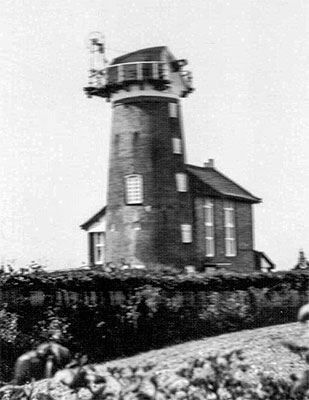 |
30th May 1939 |
With reference to the reconstruction of Weybourne Mill, I enclose a rough copy of a detailed drawing which I made of this mill in 1920. The drawing shows the mill practically intact, and may be of use if it is desirous to regain its original appearance. The owner would find ample power for electrical plant , although it is somewhat uncertain. The horse power developed depends on the size of sail. A four-arm mill, at an average breeze of 14 m.p.h., produce the following: Diameter of arms, tip to tip = 44 ft. . . . 06 h.p. Diameter of arms, tip to tip = 54 ft. . . . 08 h.p. Diameter of arms, tip to tip = 56 ft. . . 10 h.p. Diameter of arms, tip to tip = 72 ft. . . 20 h.p. The horse power produced by any size of sail can be calculated by the formula . . . . . . . . . a v3 h.p. = . ------------- where a = total sail area in feet, v = velocity of wind in feet per second. . . . . . .10,800,000 The proportions of the sails are as follows: total radius of arm or "whip" = r, length of sail = 5/6 r, breadth at end nearest axis = 1/5 r, breadth at tip = 1/3 r. Angles made by surface of sail with plane of revolution: end nearest axis = 18°, tip 7°. Efficiency 0.29. Any high-class carpenter and joiner could make them if provided with carefully prepared drawings. J. Percival-Chaplin - 1920 |
In 1929, the mill was owned by J. Sydney Brocklesby, who contemplated replacing the sails to generate electricity to supply the Mill House. As a boy, George Read did odd jobs for the Brocklesby's. |
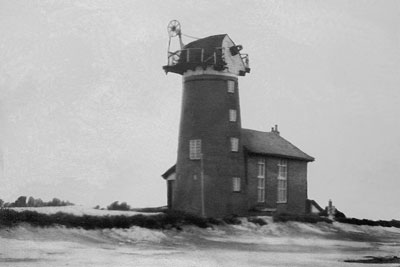 |
Winter of 1947 |
During the restoration in the 1920s, the roof of the granary that butted up against the tower was raised. This meant that the new sails installed in 1969 were considerably lower than the roof line. The four new skeleton double sails each had eight bays and were fixed to a black boat shaped cap facing east with an eight bladed skeleton fan to the rear. The gallery and stage had been removed and the stage door glazed to match the windows. |
... Weybourne, where there is a brick-built five-storied tower mill with rotating cupola, now converted into private house. In a picture of it done ten years ago it had four sweeps, a fantail and two galleries. In a picture of it taken two years ago it had no sweeps, galleries or fantail, but the owner. Mr. J. Sydney Brocklesby, was asking how to put the sails back and whether they could be used to generate electric power for heating, lighting and cooking. England of the Windmills - S.P.B. Mais - 1931 |
 |
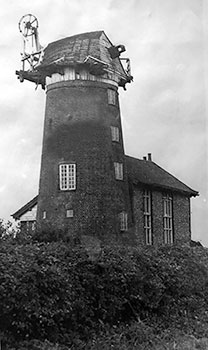 |
1951 |
c.1951 |
During the 1980s Harry Apling noted that five French burr stones were in still in the front garden along with part of the octagonal upright shaft, one glut box also still remained - they could well still be there to this day (2012). |
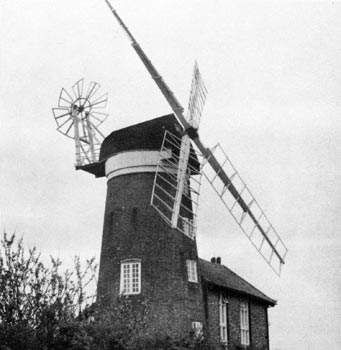 |
26th May 1970 |
A windmill at Weybourne was also struck by lightning but the only damage was a burst water pipe. ... The lightning struck one of the sails, travelled along the windshaft and burned a small hole in a brass water pipe. The sails appeared to be undamaged ... Eastern Daily Press - 4th January 1978 |
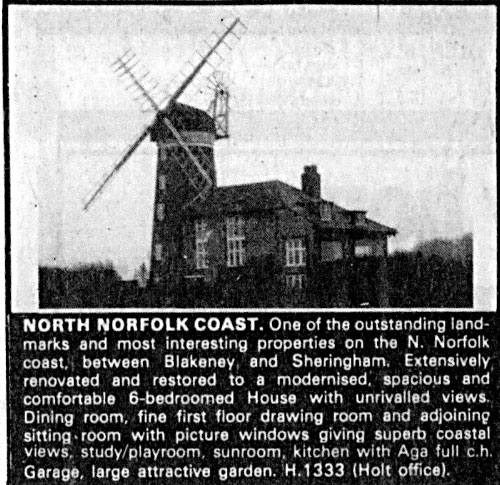 |
Eastern Daily Press advert for Turnbull & Co. - 8th & 23rd May 1981 |
Offers in the region of £138,000 Eastern Daily Press - 22nd July 1981 |
SOLD APRIL £125,000 Eastern Daily Press - 7th May 1982 |
Part of sail damaged in recent gale and removed by John Lawn. Eastern Daily Press - 5th September 1986 |
 |
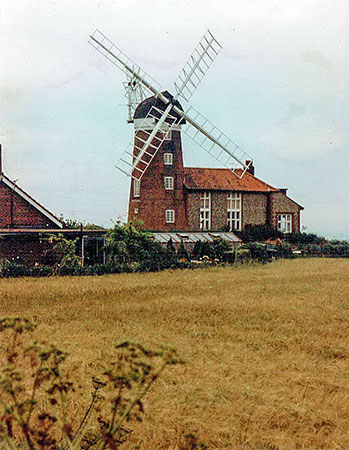 |
1989 |
1990 |
Spies in Weybourne |
The following account was supplied by Jim Baker whose cousin Rosemary Read related it to him in 2005. She was the daughter of William Read (better known as Billy) and would have been 8 or 9 years old at the time. |
There must have been about 100 German prisoners of war arrived in this part of the world in August or September 1946. They came here to work on the beach and clear all the mines from Blakeney to Mundesley, and they took over the old army-camp which used to be where Catriona Court now stands, (in Salthouse, near the pub) and before that Myngs Terrace. The RAF had it first, then the army. I think the POWs were in between the two. They were there for 15 months from August ‘46 to November ‘47, and the first winter they were there, the prisoners gave a party for all the younger children of Kelling School. They took them up to the camp here and every child had a toy - I know my sister Jasmine had a doll’s pram - and all the toys were made by the prisoners. They were very clever, they had wheels that went round and dolls’ houses and I remember a big round board with chickens on it pecking. That Christmas, there was an appeal over the radio and in the press: ‘If you have a Prisoner of War camp near you, invite a POW into your house for Christmas’ and my mother - although we were six of us home at that time - she said, ‘We’ll invite somebody.' Salthouse Local History website |
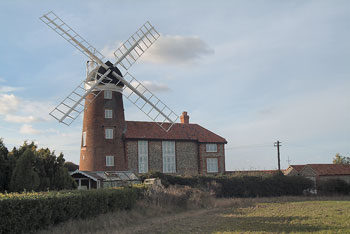 |
12th October 2003 |
The winter of 1947 was very harsh and Mr. Gasche of Gasche's Restaurant came up to the mill on his skis and brought us some eggs and milk. The snow was six feet deep and he was walking over hedges, not that he could see them. A train was stuck on the line between Weybourne and Sheringham and the people had to stay on it all night. They brought in some German prisoners of war from Salthouse to dig the roads out. Up near the woods they found a coal lorry that had been stuck there for three days and they brought us all some coal. Rosemary Read - 31st March 2005 |
First step along the road to restoration |
For more than 150 years it has stood proud in the north Norfolk landscape and been the focus for numerous postcards, photographs and paintings. But for the next few months those driving through Weybourne, near Sheringham, will notice something missing from the windmill. Having sat in position since 1969 the windmill's sails have finally succumbed to the ravages of the coastal weather and must be replaced. Yesterday a team of experts undertook the potentially dangerous work of lowering the sails, which weigh several tonnes each, to the ground. Chris Lonsdale, who directed the operation, said: "The main problem is the winds. It is not too bad on the ground but up there it is stronger and it's freezing." "The sails sit on two big spurs. We have to pin the bottom of the spur in and then chainsaw through the top half and lower it down on the crane." Using a 35 tonne crane and a long armed cherry picker it took most of the day to remove the 17m diameter sails. One of the sails slipped two feet when wedges holding it in place were dislodged during storms last November. |An inspection revealed both needed replacing rather than simply repairing. New sails must now be made and it will be a bout three months before the mill is restored to its former glory. Marjorie Martin, who has owned the mill for the past 10 years, said: "The building will look a bit sad for a while, which is a shame for all the people who like to look and photograph it, but if the work was not done it would look even worse." Eastern Daily Press - 16th February 2008 |
I used to live in the Coast Guard Cottages further on down the lane from
about 1948 to 1953. My mother, Heather Beckerson's family came from
Weybourne and she was born there. I remember going into the Windmill because we must have known the family - I do recognise the name Billy Read from my mother's memory, I went to Kelling School - may be with the daughter, I can't remember, but I used to think even when I was so young that it must be great to live in a Windmill! Thanks for your history of the place - it brought back childhood memories. Once I started searching for names, I even found pictures of my mother's brother and sister at Kelling School in the 1930s, and this may kick start me to tracing the family history which I have been trying to do for years. Jacqui Henness - 11th September 2008 |
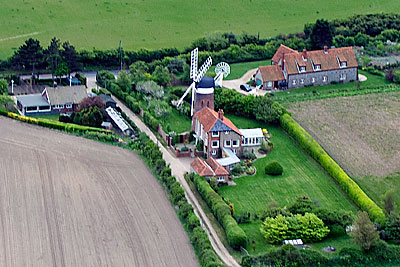 |
4th May 2009 |
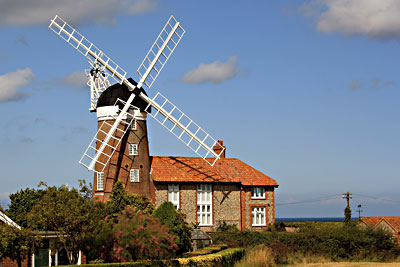 |
28th August 2012 |
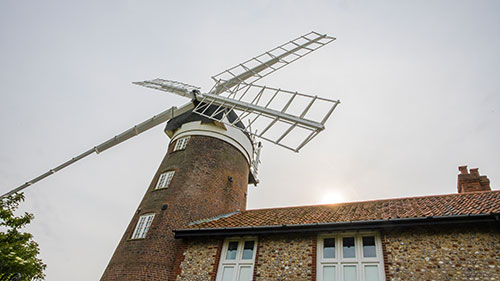 |
17th June 2023 |
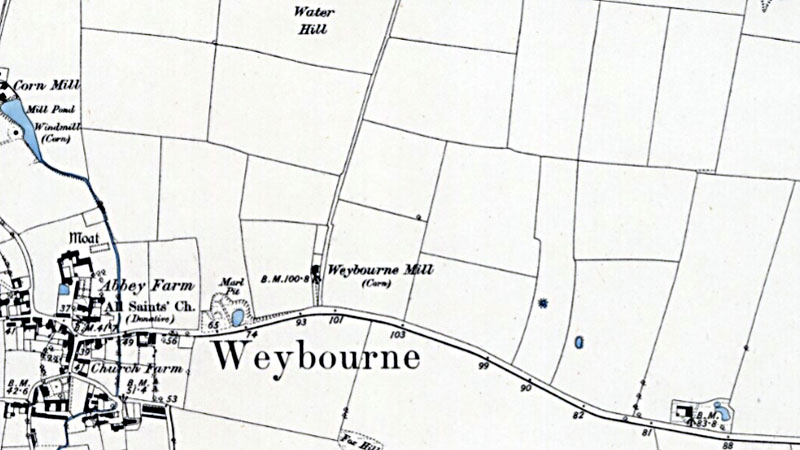 |
White's 1890: Mr. William Thomas Bird Kelly's 1925: Thomas John Youngman, assistant overseer & clerk to Parish Council
|
| 1850: Mill built 1850: Daniel Brett, miller 1853: Daniel Brett, miller White's 1854: Daniel Brett, corn miller 1857: Daniel Brett, miller 1858: Daniel Brett, miller 1859: John Dawson (also Weybourne watermill and Weybourne postmill) advertised the mill to be let 1862: John Dawson (also Weybourne watermill and Weybourne postmill) advertised the mill to be let 1865: John Dawson, miller c.1869: John Dawson bankrupt 1872: James Buckenham, miller September 1873: Mill to advertised to be let at a rent of £35 per annum 1875: Adam Aldridge, miller 1878: Adam Aldridge, miller O.S. map 1886: Windmill Kelly's 1879: William Thomas Bird, miller & farmer White's 1883: William Thomas Bird, farmer and miller 1888: William Thomas Bird, miller and farmer Kelly's 1892: James Youngman, farmer & miller (wind) Kelly's 1896: Thomas John Youngman, farmer, corn & flour dealer, wind miller & farmer Kelly's 1900: Thomas John Youngman, farmer, corn & flour dealer, wind miller & farmer & assistant overseer
Kelly's 1904: Thomas John Youngman, corn & flour dealer, wind miller & farmer & clerk to Parish Council Kelly's 1908: Thomas John Youngman, corn & flour dealer, wind miller & farmer & clerk to Parish Council Kelly's 1912: Thomas John Youngman, miller (wind) & clerk to Parish Council Kelly's 1916: Thomas John Youngman, miller (wind) & Clerk to Parish Council c.1916: Mill ceased to work c.1925: Mill restored but machinery removed except windshaft 1929: John Sydney Brocklesby. Mill with no sails, fantail or gallery Karl Wood painting 1937: Tower with cap, gallery, fanstage and windshaft but no sails 1939: Tower with cap, gallery, fan without blades, gallery, windshaft but no sails c.1942: Mr & Mrs Dodds c:1945 - 1952: William Read, Sarahann Read and daughter Rosemary Read 1951: Mill sold as part of 1,078 acre estate being sold by Lord Walpole 1955: John Sydney Brocklesby died O.S. map 1956: Windmill 1956: Mill cap and fan frame still in situ but no sails or stocks 1967: Mill bought by Mr. W.M.T. Boby of Watford 1968 New cap made and installed by William Bird & Son, Contractors Ltd. of North Walsham O.S. map 1969: Windmill Spring 1969: Skeleton sails installed by Thompson & Son of Alford, Lincs. No brakewheel, so sails were fixed August 1970: Woodwork painted with a grant from Norfolk Windmills Trust 1973: Grant from Norfolk Windmills Trust for further work 3rd January 1978: Mill sails struck by lightning bursting a water pipe 8th May 1981: Mill advertised for sale for £150,000 January May 1982: Mill sold for £125,000 1986: Dr. & Mrs. Nicholas Godlee September 1986: Part of a sail damaged in a gale removed by millwright, John Lawn 1998: Marjorie Martin 2008: Marjorie Martin 15th February 2008: Sails removed for restoration 17th June 2023: Mill secured in static position and in good condition July 2023: Mill advertised for sale by Strutt & Parker for asking price of £1,950,000 May 2024: Laurence & Deborah Harris |
If you have any memories, anecdotes or photos please let us know and we may be able to use them to update the site. By all means telephone 07836 675369 or
|
| Nat Grid Ref TG11524314 | Copyright © Jonathan Neville 2004 |